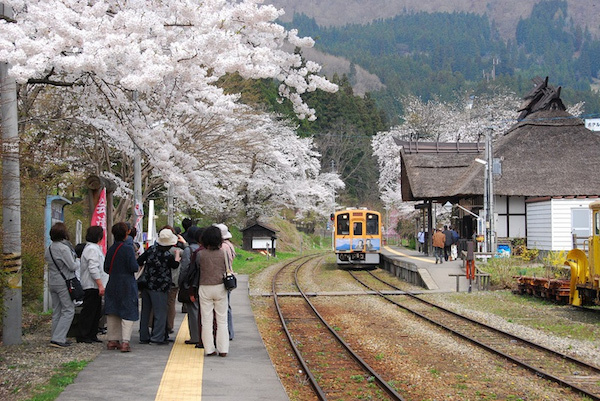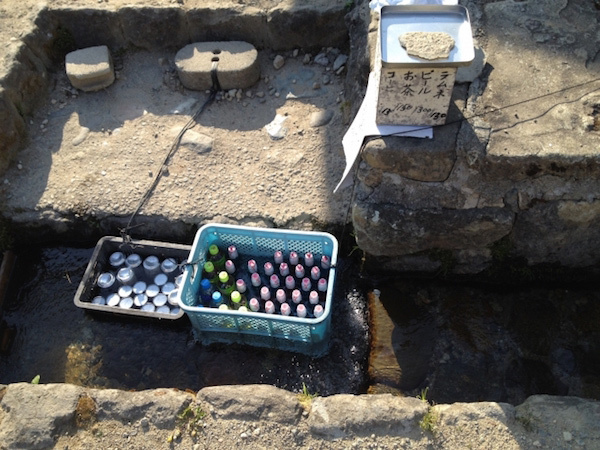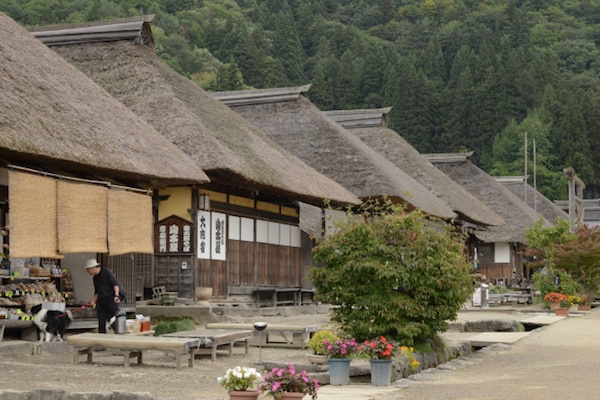A post town where people live just as they did in the Edo period
Connecting the towns of Aizu and Nikko is the Aizu Nishi Kaido.
During the Edo period (1603-1868), it flourished as an important highway connecting various parts of Aizu and Edo,
and along this road is Ouchi-juku, a small post town located about 15 km south of the city Aizuwakamatsu in Fukushima.
The scenery of this post town is remnant of good old Japan and even rivals that of the historic town of Shirakawa-go.
On both sides of the road running through the village from north to south, there are about 40 thatched-roof houses lined up,
and it feels as though you have just strayed onto the set of a period drama.
The roads are unpaved and the manhole covers are made from wood.
From the main road, you will also notice that you can’t see any of the telephone lines and electricity poles which are unique to Japan,
and any modern vibes have been erased as far as possible.
Despite this, staying at Ouchi-juku is rather easy (even if it’s not so easy getting there…)
The town has been maintained as a tourist destination, but since it hasn’t been commercialised, it has a charming simplicity to it.
Every season has its charms
One of the great things about this village is that it changes throughout the seasons.
Take spring as an example.
Although there are only a few cherry blossom trees within Ouchi-juku, the thatched roofs together with the few that are bloom is a sight you want to see at least once.
Each year at the end of April seems to be the best time to see this.
Meanwhile, the cherry blossoms along the railway line are also in full bloom at Yunokamionsen Station, the nearest station in Ouchi-juku.
This is also an impressive sight.
The station building with its thatched roof and lines of cherry blossom trees welcome many tourists who come to enjoy this beautiful view.
Then in summer, you can see vegetables and drinks being cooled by the streams flowing through the village, making you feel cooler, too.
It’s also interesting how such a sight can make you feel somewhat nostalgic, even if you’ve never seen anything like it.
If you want to buy a drink, just call over one of the shopkeepers and have a try—it tastes a little different to those chilled in a refrigerator.
This is an Ouchi-juku experience that’s only possible because there’s plenty of clean water flowing through the village.
Next comes fall when the mountains are painted in hues of red, and this is the busiest season throughout the whole year.
Smoke from the hearth trails out of thatched roofs against the painted trees in the background, creating a truly autumnal landscape unique to Japan.
From the middle of October to the middle of November, many people head to Ouchi-juku and the roads become crowded,
so it’s best to arrive before 10 am.
Of course, winter is also beautiful.
Located in the mountains, it starts snowing here in December and the village gets completely covered in white.
During these winter months, fewer shops are open and there are also fewer tourists,
but you do get to see another side to Ouchi-juku—one that isn’t a tourist destination and has sights like daikon radishes being dried outside the houses.
Plus, there’s the Ouchi-juku Snow Festival which takes place throughout the winter months.
Snow lanterns are lit at night during this event, and the soft glow of the snow lanterns together
with the blanket of snow that lies on top of the thatched roofs is a magical sight that must be seen.
The history of Ouchi-juku
During the Edo period, Ouchi-juku flourished as a post town along the Aizu Nishi Kaido, which leads from Aizu to Nikko.
The one who maintained this road was the daimyo feudal lord, Hoshina Masayuki.
He was a wise ruler who was widely celebrated, and was also the half-brother of Tokugawa Iemitsu, the third shogun of the Tokugawa shogunate.
The road had an important role, not only providing a way for Hoshina to take his turn attending on the Shogun in Edo, which is now modern-day Tokyo,
but also as a way to transport rice and specialty products to the capital.
From the Meiji Era (1868-1912),
the government proceeded to introduce modernisation policies which were implemented along the Agano River, not the Aizu Nishi Kaido.
Because of this, Ouchi-juku became a village that was isolated from the surrounding areas and left behind not only by modernisation,
but also by the high economic growth after World War II.
There are even stories of harassment taking place in the Aizu region which resisted the Meiji government to the very end.
However, since this mountain village was left behind by economic growth, ]
it began attracting a lot of attention from tourists as an inn town reminiscent of the Edo period.
Even so, a wave of modernisation swept through in the 1970s and transformed the village,
with corrugated iron replacing the thatched roofs and the streets being paved.
But thanks to the villagers own conservation efforts,
they have revived the traditional thatched roofs and continue to maintain the rows of old-fashioned houses.
How to access Ouchi-juku
A village nestled deep in the mountains, access to Ouchi-juku is somewhat difficult.
If you’re taking the train, then there are 2 options.
You can either take the normal Zairaisen line from Asakusa which involves making several transfers,
or take the Shinkansen heading towards Koriyama from Tokyo Station to Aizuwakamatsu.
Both of these routes take around 3 and a half hours.
Personally, the route along the normal Zairaisen line is the best.
The trouble of heading out from the city along the tracks of the Aizu Kinugawa line,
Yagan Railway, Aizu Railway, is all part of the essence of Ouchi-juku.
When you finally arrive after a long and bumpy journey,
you can enjoy just how much of an accomplishment it is that the village remains the same as it did in the Edo period.
Plus, each town and station you visit along the way is unique to itself.
The area around Kinugawa Onsen, a spa town in Nikko, is a well-known tourist destination,
and there’s also the beautiful To-no-Hestsuri valley as well as Yunishigawa Onsen.
This is believed to be one of the “Heike-no-Ochudo” settlements, said to be created by fugitives who survived the Genpei War,
a struggle for power that took place during the 11th century, and who lived deep in the mountains to avoid being captured.
You should definitely head to Ouchi-juku while enjoying stopovers along the way, including Yunokamionsen Station,
the closest one to Ouchi-juku which also has a thatched-roof.
There’s also a free foot bath inside the station,
so make sure you take the chance to wash away your fatigue after a long train journey.
If you’re travelling by railway (neither the Yagan Railway nor the Aizu Railway use electric trains!),
you can take either a bus or a taxi from Yunokamionsen Station.
It’s only about 10 minutes from here so if your train times don’t match up with the bus times, you can just take a taxi.
The best route to make the most of Ouchi-juku!
The first spot you’ll get off at is the parking lot at the village entrance.
There’s a small hut within the parking lot which is the Ouchi-juku Tourist Information Centre, so drop by here first.
1. Pick up a pamphlet
Head inside the information centre and take one of the pamphlets.
You’ll find that some shops are hidden away from the rest or situated behind the main street, so the pamphlet is useful to have as a guide.
Once you have one, head into the village.
About 100 m away from the parking lot, you’ll see some old buildings to your right and a view of the countryside to your left.
Already you’ll start to feel the atmosphere and charm of the village.
I went during autumn and there were dried persimmons hanging outside the buildings, and although it may have only been for show,
I remember thinking how nice it was.
Then, just around a slight corner, the post town suddenly appears.
2. Wander around the thatched-roof homes
There are private houses with thatched roofs running along both sides of the dirt road, which runs straight for about 1 km.
In front of the houses is a waterway where clear water flows down the road, as well as shops selling fish and dango cooked over charcoal.
Immerse yourself and feel what it would have been like to be a traveller in the Edo period, arriving in town after having crossed mountains to get there.
Now let’s take a walk around the post town.
There’s a gentle uphill slope as you head down the road, but you can easily enjoy it without feeling worn out.
It’s really surprising that this isn’t a movie set and that people are actually living in these houses.
There’s also a back street and if you wander down there, you’ll find that it’s unexpectedly modern,
so it might be fun to take a look once you’ve enjoyed all there is to see on the main street.
3. Takakura Shrine
As you walk along the main street, you’ll see a splendid torii gate on your left hand side in the middle of the town.
This is the torii gate to Takakura Shrine, the guardian deity of Ouchi-juku.
Make a short stop off here.
Head through the first torii gate and carry on walking for about 5 minutes until you see the second one.
Beautiful countryside surrounds you and from here you can enjoy a view of the natural landscape which differs to the main street.
Head even further along the path and you’ll find Takakura Shrine where Prince Mochihito is enshrined.
A powerful person during the 11th century, he rebelled against the military leader, Taira no Kiyomori,
and is said to have stayed at Ouchi-juku while fleeing to safety after his defeat.
4. Townscape Exhibition Hall
Head back to the first torii gate and just in front of it you will find the Townscape Exhibition Hall.
This building is a reconstruction of the one that was once used as the headquarters during the Edo period when Ouchi-juku was a post town,
and currently has around 1,300 tools and photographs on display to show the customs of that time.
By seeing how people would have lived and learning about the history, you can enjoy Ouchi-juku just that little bit more.
・Opening hours 09:00 to 16:30
・Admission fee Adult 250 yen, Child 150 yen
Group admission fee (30 people)
Adult 200 yen, Child 100 yen
Continue heading down the road and at the far end there’s the Asanumaya house.
This was once the town’s lookout spot, but it’s now used as a restaurant.
Behind this building, you will find the highlight of Ouchi-juku.
5. Viewing Spot
The viewing spot at the farthest point of the town is one of the best spots for taking photos in the whole of in Ouchi-juku.
You do have to climb some slightly steep steps,
but from there you will get a bird’s-eye-view of all the thatched-roof houses standing in a line along the main road.
The only things you can see are the surrounding nature and the thatched roofs, making it feel like you've actually gone back in time to the Edo period.
Next to the viewing spot you will also find the guardian deity of women and children, Koyasu Kannon,
said to bring benefits to those who pray to be blessed with children and safe childbirth.
Don’t miss out on the food in Ouchi-juku
・ Takato Soba (Negi Soba)
‘Takato’ comes from the name of a place in the Ina region of Nagano Prefecture.
Hoshina Masayuki, the first lord of the Aizu Matsudaira clan in Ouchi-juku, had originally ruled over the Takato clan.
Then, when he was transferred to the Tohoku region, he brought a soba craftsman with him, which is why it became known as ‘Takato soba’.
Takato soba has a broth made with hot daikon radish, and a variety of this is called ‘Negi soba’.
‘Negi’ is a spring onion in Japanese, but this doesn’t actually mean that the dish is filled with a helping of spring onions.
Rather, the soba noodles are actually eaten using long spring onions instead of chopsticks.
It’s not as easy as eating with chopsticks, but it’s a fun dish to eat while also enjoying the flavour of the spring onions.
But why use long spring onions?
It seems the idea actually came about from a local custom of putting spring onions into a small bowl and wishing for the prosperity of descendants.
There are several shops around Ouchi-juku where you can try this style of soba, but my personal recommendation is Ishiharaya.
This was once used as a Waki-Honjin, a type of inn used by government officials of a lower status, and so the building itself has a very quaint feel to it.
And of course, the handmade soba noodles both smell and taste delicious.
Their Negi soba costs 950 yen.
・ Shingoro
This is a local dish made by skewering balls of half-cooked rice, coating them in a sweet miso paste made from sesame seeds,
and then grilling them over charcoal.
It has a fragrant scent and a chewy texture.
Holding them by the stick, you can eat these as you wander down the street, and as there are a number of stalls selling them,
it’s entirely your choice where you buy them from.
They cost more or less 250 yen each, including tax.
Ouchi-juku’s big event—the Snow Festival
The Ouchi-juku Snow Festival takes place on the second Saturday and Sunday in February every year.
Originally a village ritual, tourists have also been able to take part for the last 30 years.
During the day, various competitions take place including soba eating, costumes and log cutting.
Registration for competitions stays open until about 30 minutes before the start, so tourists can also jump in at the last minute to participate.
The festival’s main event takes place at night.
Snow lanterns are made alongside the main road and set alight, creating a magical atmosphere throughout the whole of Ouchi-juku.
Then there’s the ritual which begins at around 5 pm, when a sacred fire is taken from the altar of Takakura Shrine,
which sits to the rear of Ouchi-juku.
Wearing waistcloths, local men then run through the village with the fire and light the torch that’s in front of the main shrine.
After that, there’s a firework display which takes place from 6 pm.
As the fireworks hit the wintery night sky, they light up the snow-covered Ouchi-juku and create a unique sight that can only be seen here.
This is a beautiful place to visit during any time of the year,
but the very best has to be when you can see these precious snow scenes which are limited to just a few days of the year.
 JAPAN Travel Concierge
JAPAN Travel Concierge


























